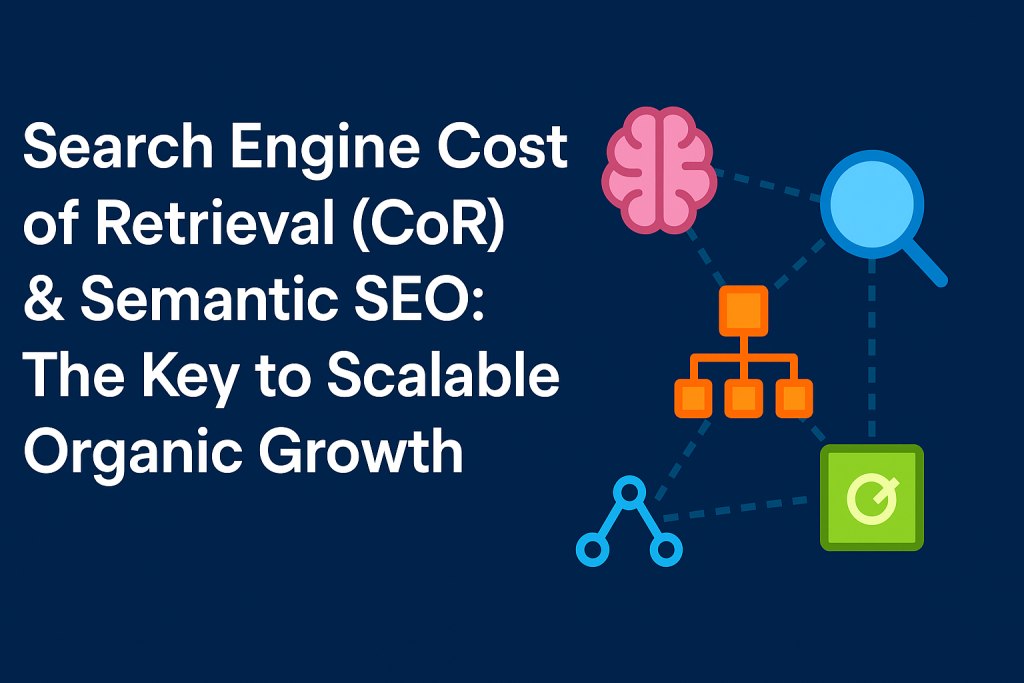
Search Engine Cost of Retrieval (CoR) & Semantic SEO: The Key to Scalable Organic Growth
In modern SEO, success isn’t just about keywords or backlinks—it’s about how efficiently search engines can retrieve, understand, and rank your content. This is where Search Engine Cost of Retrieval (CoR) and Semantic SEO, as championed by experts like Koray Tuğberk GÜBÜR, intersect.
By lowering your site’s retrieval cost and aligning your content with entity-based, semantically rich structures, you’re not just optimizing pages—you’re building an ecosystem that search engines love.
What Is Cost of Retrieval (CoR)?
Cost of Retrieval refers to the computational resources a search engine expends to crawl, render, and index a webpage. If your page is technically heavy, slow, or semantically vague, it becomes “expensive” to process—and may be crawled less often or ranked lower.
In the semantic web, retrieval cost isn’t just about load speed—it’s about how efficiently a search engine can map your content to entities, contexts, and user intent.
Why CoR + Semantic SEO = Modern Optimization
Search engines today operate on semantic understanding, not string-matching. Combining technical efficiency (low CoR) with semantic clarity (entity-driven content) results in:
- Faster Crawling & Indexing: Low CoR means bots can discover and render more pages within your crawl budget.
- Better Context Matching: Semantically organized content helps search engines map your pages to user intent and known entities.
- Stronger Topical Authority: Structured internal linking, entity definitions, and contextual clarity signal expertise within a topic cluster.
- Sustainable Rankings: Content that is both technically optimized and semantically accurate is more resilient to algorithm updates.
Signs Your Site Has High Retrieval Cost (CoR)
- Page load times > 2.5s
- Overuse of client-side JavaScript
- Lack of structured data or entity references
- Important pages >3 clicks from homepage
- Thin, duplicate, or contextless content
- Unresolved crawl errors or redirect chains
How to Reduce CoR & Enhance Semantic Strength
1. Optimize Crawl Efficiency
- Flatten your site architecture (max 2–3 click depth)
- Use contextual internal linking to establish entity connections
- Remove low-value, duplicate, or zombie pages
- Submit focused, updated XML sitemaps
2. Improve Technical Performance
- Use CDNs, lazy loading, and server-side rendering (SSR)
- Compress images (WebP) and scripts (minify, defer JS)
- Ensure mobile and Core Web Vitals compliance (LCP, CLS, FID)
3. Build Entity-Based Content Networks
Following Koray’s semantic SEO philosophy:
- Map your topics to named entities (e.g., from Google’s Knowledge Graph or Wikidata)
- Define each entity clearly using content hubs, FAQ sections, and glossaries
- Use semantic HTML (H1–H6, schema.org markup) to show relationships between entities
- Avoid keyword cannibalization by assigning unique intent and context to each URL
4. Topical Authority Through Interconnected Contexts
- Create topical maps: start with a main entity and branch into subtopics and related queries
- Link internally using descriptive, semantically rich anchor texts (e.g., “drinking water contaminants” instead of “click here”)
- Ensure content depth and precision to reduce ambiguity for NLP models like BERT
Semantic SEO Techniques to Pair with Low CoR
| Strategy | Benefit |
|---|---|
| Entity-Based Optimization | Helps search engines disambiguate content and connect topics |
| Topical Clustering | Establishes authority and reduces retrieval ambiguity |
| Semantic Content Layout | Improves parsing efficiency for crawlers and NLP models |
| Unique Context Per URL | Prevents dilution of intent and confusion during indexing |
| Context-Carrying Internal Links | Reinforces semantic hierarchy and navigability |
Advanced Monitoring & Tools
Tools to Track CoR:
- Google Search Console → Crawl stats, index coverage
- Screaming Frog / Sitebulb → Crawl depth, rendering issues, thin/duplicate content
- PageSpeed Insights → Core Web Vitals and page load diagnostics
Tools to Apply Semantic SEO:
- Inlinks → Entity audits, internal linking automation
- WordLift → Schema and knowledge graph integration
- SEMrush/SurferSEO → NLP scoring and topical gap analysis
- Google NLP API / Diffbot → Entity extraction and topic modeling
Common Mistakes That Inflate CoR or Undermine Semantic Relevance
- Deep folder structures with no semantic cohesion
- No topical hierarchy or interlinked content maps
- Relying on raw keywords instead of user-centric language and entities
- Poor JS rendering that hides primary content from bots
- Orphan pages with high semantic value but no internal links
Future of SEO: Low Retrieval Cost, High Entity Clarity
Search engines are evolving toward zero ambiguity, where content that best matches user intent + contextual relevance + technical efficiency wins.
That means:
- Fast-loading, mobile-optimized pages
- Rich semantic markup and entity associations
- Intent-matched, interlinked topic clusters
In this model, SEO becomes about engineering discoverability: not just being found, but being understood.
Search Engine Cost of Retrieval is no longer just a technical metric—it’s a strategic SEO layer. When paired with semantic SEO practices, it drives long-term visibility, scalable traffic, and algorithm-proof rankings.
Remember, the content that’s easiest for search engines to retrieve and understand is also the most valuable to users—and the most likely to rank.